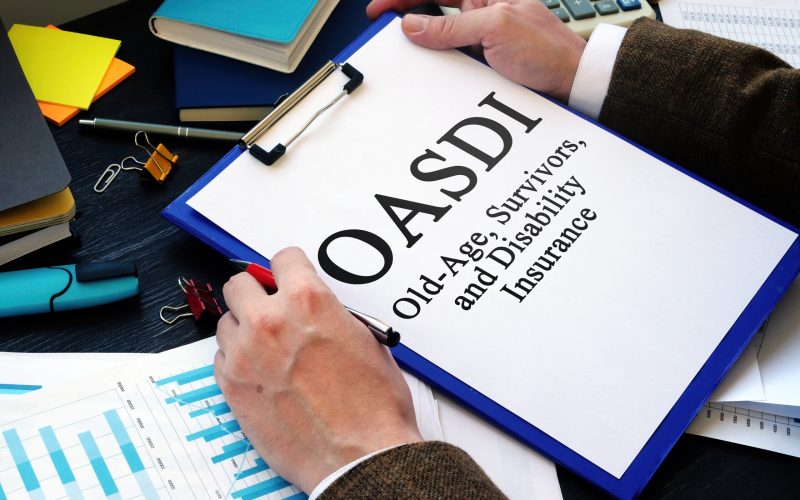If you don’t pay attention to your paycheck’s deductions and withholdings, you may be unaware of the OASDI tax.
You don’t need to know, after all. You’re going to have to pay it one way or another. You could argue that the specifics are unimportant. However, you may argue that it is prudent to understand where your money is going.
Here’s a more in-depth look at the OASDI tax, including what it is, how it works, and how much you have to pay.
What Is OASDI Tax?
The abbreviation OASDI stands for Old Age, Survivors, and Disability Insurance. The OASDI tax pays for a significant amount of a program you’re probably already familiar with Social Security.
The money collected by employers from employee paychecks for the OASDI tax is used to fund the Social Security program. The OASDI program restricts the number of earnings that are taxed each year. This annual limit varies from year to year. The Social Security Administration (SSA) announced that the maximum pay due to the old age, survivors, and disability insurance (OASDI) tax will rise to $142,800 in 2022, up from $137,700 in 2020. The OASDI tax rate is 6.2 percent, which means that an employee earning up to or above the maximum in 2022 will pay $8,853.60 in tax, with the employer paying the same amount. Self-employed individuals pay tax at a 12.4 percent rate up to the ceiling, for a maximum OASDI tax of $17,707.20.
The Medicare hospital insurance tax, which is 1.45 percent for employees and employers and 2.9 percent for self-employed people, has no wage cap.
The SSA also announced that recipients of Social Security benefits will receive a 1.3 percent cost-of-living adjustment, that the earnings test for the amount of income that benefits recipients can receive without having their benefits reduced each year is $18,960 before full retirement age, and that the limit taxpayers can earn in the year they reach full retirement age is $50,520, both of which have been increased.
What Is the Old-Age, Survivors, and Disability Insurance Program (OASDI)?
The official term for Social Security in the United States is the federal Old-Age, Survivors, and Disability Insurance (OASDI) program. The OASDI tax, which appears on your paycheck, funds this comprehensive federal benefits program, which compensates retirees and disabled persons, as well as their spouses, children, and survivors. The program’s purpose is to replace some of the income lost due to old age, the death of a spouse or eligible ex-spouse, or disability.
Employers, employees, and self-employed individuals all contribute to OASDI through payroll taxes. Here is a more detailed breakdown of what your contributions to OASDI cover:
What Is Involved in the OASDI Tax?
#1. Assistance in elderly age.
When qualified contributors reach retirement age, they will begin receiving monthly benefits that will replace a portion of their pre-retirement income.
#2. Survivors are compensated.
The amount of survivors’ benefits is determined by the earnings of the deceased relative. The larger the survivors benefit, the more the deceased relative paid into Social Security. The monthly benefit amount is calculated as a percentage of the deceased’s base Social Security benefit.
#3. Death Benefits in a Single Installment
If a surviving spouse or kid meets certain criteria, they may be eligible for a lump sum payout of $255.
#4. Disability benefits are available.
The Social Security Disability Insurance (SSDI) program offers benefits to eligible contributors and their dependents. In addition, the Supplemental Security Income (SSI) program offers benefits to eligible individuals and their children.
Is the OASDI Tax Mandatory?
OASDI is a federally mandated benefit to which all employees are required to contribute. Only a few exceptions exist to this rule. Members of certain religious groups may be exempt from Social Security taxes, but they must surrender their benefits rights to do so.
Contributions to FICA, SECA, and OASDI
The amount paid by employees, employers, and self-employed workers varies because the OASDI tax is deducted directly from payroll contributions. People can contribute to OASDI in two ways: through FICA or SECA.
Contributions from Employees and Employers
FICA, which stands for the Federal Insurance Contributions Act, is a tax on both employers and employees. It levies taxes on both companies and employees to fund Social Security and Medicare (aka the FICA tax).
Employers make matching contributions to the monthly percentage of income that employees pay. For 2023, the OASDI tax rate for Social Security coverage is set at 6.2 percent of net earnings and 1.45 percent for Medicare coverage (a total of 7.65 percent ).
Contributions from Self-Employed Workers
Self-employed individuals, on the other hand, must pay for both sides of the OASDI contributions – basically matching their contributions. Self-employed individuals pay SECA, commonly known as the Self-Employment Contributions Act, rather than FICA tax.
This means that if your company is an S-Corp, Sole Proprietorship, or Partnership, you must pay OASDI through SECA. The SECA tax rate is 15.3 percent of net earnings as of 2022, which is the same as the amount a company and employee would pay jointly under FICA.
If you are a self-employed person who is concerned about paying excessive taxes in comparison to an employee, don’t worry: there is a solution to alleviate the load. Since self-employment tax is deductible as a business expense, half of the SECA tax can be deducted from income tax.
This can be done on Line 6 of the Form 1040 Self-Employment tax form.
Current Trends on the OASDI Tax
The maximum amount of income taxed for Social Security in 2022 was $142,800, a $5,100 increase from 2020. That means that in 2023, the most anyone can pay into Social Security is $8,853.60 (6.2 percent of the maximum income of $142,800).
The Medicare tax rate, on the other hand, has a different cap. Employees pay 1.45 percent tax on their first $200,000, then 2.35 percent on everything over $200,000 ($250,000 for joint returns; $125,000 for married taxpayers filing separately). Wages over $200,000 will be taxed at a rate of 2.35 percent ($250,000 for joint returns; $125,000 for married taxpayers filing a separate return).
Remember that if you are self-employed, those rates will almost double to cover both employer and employee coverage, however, you can deduct half of those expenditures on your yearly Form IRS 1040.
Self-employed individuals pay 2.90 percent Medicare tax on the first $200,000 of self-employment income and 3.8 percent (2.90 percent standard Medicare tax + 0.9 percent additional Medicare tax) on all self-employment income above $200,000. As with employers and workers, these restrictions are reduced to $250,000 of combined self-employment income if filed jointly, and $125,000 for married taxpayers filing separately.
Contribution and benefit bases, 1937-2021
| Year | Amount | Year | Amount | Year | Amount |
|---|---|---|---|---|---|
| 1937-50 | $3,000 | 1986 | $42,000 | 2006 | $94,200 |
| 1951-54 | 3,600 | 1987 | 43,800 | 2007 | 97,500 |
| 1955-58 | 4,200 | 1988 | 45,000 | 2008 | 102,000 |
| 1959-65 | 4,800 | 1989 | 48,000 | 2009 | 106,800 |
| 1966-67 | 6,600 | 1990 | 51,300 | 2010 | 106,800 |
| 1968-71 | 7,800 | 1991 | 53,400 | 2011 | 106,800 |
| 1972 | 9,000 | 1992 | 55,500 | 2012 | 110,100 |
| 1973 | 10,800 | 1993 | 57,600 | 2013 | 113,700 |
| 1974 | 13,200 | 1994 | 60,600 | 2014 | 117,000 |
| 1975 | 14,100 | 1995 | 61,200 | 2015 | 118,500 |
| 1976 | 15,300 | 1996 | 62,700 | 2016 | 118,500 |
| 1977 | 16,500 | 1997 | 65,400 | 2017 | 127,200 |
| 1978 | 17,700 | 1998 | 68,400 | 2018 | 128,400 |
| 1979 | 22,900 | 1999 | 72,600 | 2019 | 132,900 |
| 1980 | 25,900 | 2000 | 76,200 | 2020 | 137,700 |
| 1981 | 29,700 | 2001 | 80,400 | 2021 | 142,800 |
| 1982 | 32,400 | 2002 | |||
| 1983 | 35,700 | 2003 | |||
| 1984 | 37,800 | 2004 | |||
| 1985 | 39,600 | 2005 |
Note: The amounts for 1937-1974 and 1979-1981 were fixed by statute; all other amounts were determined using the Social Security Act’s automatic adjustment provisions.
Why were My OASDI Taxes Deferred?
To provide aid during the COVID-19 epidemic, the OASDI tax withholdings of employees who fulfilled the pay criteria were deferred, according to a Presidential Memorandum published on August 8, 2020, and Internal Revenue Service Notice 2020-65 released on August 28, 2020.
The Consolidated Appropriations Act of 2021 was passed, which extended the deadline for collecting deferred Social Security taxes for 2020. The collection period has been extended to January 1, 2021, through December 31, 2021.
The 2020 Social Security tax deferral will expire at the end of December. Beginning in January 2021, the standard 6.2 percent Social Security tax withholdings will be withheld from wages for military members and civilians, as well as an additional deduction for the deferred 2020 Social Security tax collection.
The Social Security taxes delayed in 2020 will be paid from pay between January 1 and December 31, 2021, according to IRS advice (as modified by the Consolidated Appropriations Act, 2021).
Military Personnel –
The 2020 deferred Social Security taxes will be collected in 24 payments from your mid-month and end-of-month salary between January 1 and December 30, 2021, for active-duty military members.
In 2021, the amount collected may not be the same for reservists and guardsmen undertaking intermittent duty. DFAS will collect 2% of net available from each weekly, mid-month, and an end-of-month paycheck until the deferred taxes are fully repaid.
Beginning in January 2021, your myPay LES will show the monthly collection amount as well as a statement in the notes area indicating the balance of deferred Social Security taxes.
Civilian Workers –
The amount of Social Security taxes postponed in 2020 will be collected in 24 installments between January 16 and December 4, 2021 pay periods. Social Security taxes postponed in 2020 will be collected on December 18, 2021, in some situations.
Beginning in January 2021, the 2020 deferred OASDI collection amount in that pay period, as well as the remaining balance to be collected, will be included in your myPay LES Remarks section.
NOTE
If you separate or retire before the deferred Social Security tax is fully collected, the unpaid balance may be deducted from your final salary or you may receive a debt notice with repayment instructions. The debt management mechanism will be used for collection. You will receive a debt letter in the mail, along with repayment instructions. Pay.gov is a website where you may make payments online.
Contribution Limits and Other Important Contributions
The maximum amount of income tax for social security in 2016 was $118,500, a $1,500 increase over 2015. The Social Security Administration has announced that the wage cap will not be raised in 2016. That means that the highest amount somebody can pay into social security in 2016 is $7,347.
The Medicare tax rate, on the other hand, has a different cap. Employees are taxed at a rate of 1.45 percent on their first $200,000, and then at a rate of 2.35 percent on any amount over $200,000. Remember that if you work for yourself, the prices will be quadrupled to include employee and employee coverage, but you can deduct half of those expenditures on your yearly 1040.
What is the Maximum Amount of OASDI tax?
The OASDI tax only applies to earnings or salary income up to a set amount, which varies from year to year. The maximum amount subject to OASDI tax in 2020 is $137,700. That means the highest you’ll have to pay in OASDI tax is $8,537.40, or double that if you’re self-employed.
It should be noted, however, that you may be required to work for any unpaid OASDI tax. For example, if you work two jobs with total incomes that exceed the $137,700 limit, your employers may withhold too much in OASDI tax. You can claim excess paid OASDI tax on your income tax return, which will result in a refund of the overpaid amount.
Do All of My OASDI Tax Dollars Go to Social Security?
Near but not quite. According to the Social Security Administration, 85 cents of every dollar spent on OASDI is put into a trust fund that distributes monthly payments to current retirees and their families, as well as surviving wives and children of workers who have died. Around 15 cents of every dollar goes to a trust fund that provides benefits to people with disabilities and their families. The reason it’s “approximately 15 cents” is that a small portion of what’s leftover – less than a penny for every dollar contributed – goes into managing the Social Security program.
What Percentage of My Paycheck Is Deducted for the OASDI Tax?
“Employees pay 6.2 percent of their salaries, and employers match at 6.2 percent, for a total of 12.4 percent that goes to the federal government,” explains Katelyn Magnuson, creator of The Freelance CFO LLC, an accounting firm for freelancers.
Do you have to pay the OASDI tax if you’re self-employed?
In a nutshell, yes and no. Technically, you don’t (payments aren’t deducted automatically from the checks or direct deposits you receive). However, you are required to pay the OASDI tax. You are responsible for paying the 12.4 percent.
You will owe back taxes if you do not pay those taxes. There is no way out of this.
However, instead of 6.2 percent, I must pay 12.4 percent in self-employment taxes. Is Being Self-Employed Punishing Me?
It appears like way, but it isn’t. The explanation is as follows:
If you’re self-employed, you can deduct the employer part (6.2 percent) to help level the playing field. OASDI is paid on wages up to a maximum of $142,800.
The $142,800 figure is for 2021. It varies from year to year. Self-employed taxpayers contributed 12.4 percent of their income to the OASDI tax last year, up to $137,700.
After that point, you and your employer are not liable for the 12.4 percent tax on any income made above that amount. This is also one of the reasons that many solopreneurs/single-member LLCs pick an (S-corporation) election once they reach a particular income threshold. Because OASDI is only paid on earned earnings, S-corps pay it only on the salaries reported on their W-2s, and they don’t pay the tax on the dividends they receive from their firm. A sole proprietor or single-member LLC, on the other hand, will pay the 12.4 percent tax on all income up to the $142,800 threshold.
So, if I earn more than $142,800, I won’t have to contribute to Social Security?
Yes, but don’t start spending money you haven’t yet earned. Since you mentioned it, President Joe Biden offered a plan during his campaign to raise the maximum to $400,000. It is predicted that this would enhance Social Security revenue by $740 billion over the following ten years.
Can I Avoid Paying the OASDI Tax?
No, for the most part. If you fill out IRS Form 4029, Application for Exemption From Social Security and Medicare Taxes and Waiver of Benefits, and the Internal Revenue Service agrees with your case, you may be allowed to avoid paying the OASDI tax.
If you belong to a qualifying religious group, you may be able to avoid paying. This is, however, extremely unusual. You and your employer must both be members of the religious group, which must have existed continuously since or before December 31, 1950, among other requirements. Some nonresident aliens may be exempt from paying the OASDI tax (though most do). Employees of foreign governments may be exempt.
But for the vast majority of people reading this, it’s a foregone conclusion. You’re the one who has to pay for it. But, at the very least, you’ll receive your money back once you begin getting Social Security checks.
Understanding the Program for Old-Age, Survivors, and Disability Insurance (OASDI)
The United States Social Security program is the world’s largest such system, as well as the largest expenditure in the federal budget, with an estimated cost of $1.2 trillion in 2021.
According to the Social Security Administration, nearly nine out of ten people aged 65 and up receive Social Security benefits (SSA). Social Security computes your AIME (average indexed monthly earnings) for the 35 years in which you earned the most.
The Social Security Act, signed by President Franklin D. Roosevelt on August 14, 1935, when the United States was in the grip of the Great Depression, ushered in the program.
The program has expanded dramatically throughout the years, paralleling the growth of the US population and economy. In 1940, around 222,000 persons received a monthly benefit of $22.60 on average. By the end of 2020, that figure would have risen to approximately 70 million. The average monthly benefit for 2021 is $1,543.
Payroll Tax on OASDI
Payments to qualified individuals are paid by OASDI taxes, which are government-collected payroll taxes known as FICA taxes (short for Federal Insurance Contributions Act) and SECA taxes (short for Self-Employed Contributions Act). In 2021, the Social Security tax rate for employees is 6.2 percent, while the self-employed pay 12.4 percent.
These earnings are held in two trust funds:
- The Retirement Old-Age and Survivors Insurance (ASI) Trust Fund
- The Disability Insurance (DI) Trust Fund is a trust fund for disability insurance.
These trust funds give out benefits and invest the remaining earnings.
The amount of annual earnings for which you must pay Social Security tax is limited. In 2021, the maximum taxable earnings are $142,800.
Read Also: TEXAS SMALL BUSINESS GRANTS: Best Tips to Becoming Beneficiaries
Criteria for the OASDI Program
People who meet specified criteria are eligible for benefits under the OASDI program. Money is paid to qualifying individuals beginning at the age of 62 for old-age payments. The full retirement age varies by birth year and is 67 for everyone born in 1960 or after. Due to delayed retirement credits, qualified individuals who wait until the age of 70 (but no later) to begin receiving benefits can get greater, maximum payments.
Payments are computed using people’s earnings when they were of working age. Survivors’ payments are paid to the surviving spouses or qualified children of deceased or retired employees. Disability payments are paid to eligible individuals who are no longer able to engage in a substantially gainful activity and meet other conditions.
A worker must be fully insured to be eligible for retirement benefits. By accumulating credits (also known as quarters) of coverage, a worker can become fully covered. Credits or quarters are acquired based on the number of covered wages earned during a certain period. In 2021, a worker will receive one-quarter of coverage for every $1,470 earned. The monetary value is indexed for inflation every few years. A worker can earn up to four credits or quarters of coverage every year, with a total of 40 credits required to be eligible for benefits.
What is the future of OASDI?
Some policymakers have suggested that the 6.2 percent OASDI tax may not be sufficient to usher us into the twenty-first century. According to the 2019 Social Security Trustees Report, raising the OASDI tax to roughly 7.55 percent would be enough to keep the Social Security program sustainable for the next 75 years. Otherwise, benefit reductions will be required to maintain the program fiscally stable.
Nonetheless, the 6.2 percent rate has been in place since the 1990s, and few are eager to change it. With most predictions giving the government until the mid-2030s to solve the Social Security budget crisis before benefit changes are required, the OASDI tax is expected to remain unaltered for the foreseeable future. This is likely to continue until Washington lawmakers gain the necessary momentum to address the politically charged topic in the future.
Where can I get more information about OASDI Tax?
For more information about OASDI Tax, you can contact the Internal Revenue Service (IRS) or consult the IRS website. You can also speak with a tax professional or financial advisor for guidance.
What happens if I owe OASDI Tax from a previous year?
If you owe OASDI Tax from a previous year, you may be required to pay the amount owed plus any interest and penalties that have accrued. The IRS may take enforcement actions such as wage garnishment or seizure of property if you do not pay the amount owed.
Can I make estimated OASDI Tax payments throughout the year?
Yes, you can make estimated OASDI Tax payments throughout the year. This can help you avoid a large tax bill at the end of the year and prevent penalties for underpayment.
How does my employment status affect my OASDI Tax liability?
Your employment status can affect your OASDI Tax liability. If you are self-employed, you will be responsible for paying the full amount of OASDI Tax, while if you are an employee, your employer will typically withhold half of the OASDI Tax from your pay and pay the other half on your behalf.
Can I choose to opt out of paying OASDI Tax?
No, you cannot choose to opt out of paying OASDI Tax. OASDI Tax is a mandatory tax that is required by law.
Is there a difference between OASDI Tax and Medicare Tax?
Yes, there is a difference between OASDI Tax and Medicare Tax. OASDI Tax is a payroll tax that helps fund Social Security, while Medicare Tax is a payroll tax that helps fund the Medicare program. The two taxes have different rates and are calculated differently.
OASDI Tax FAQs
Do employees have to repay the OASDI tax deferral?
Yes. The OASDI tax-deferred in 2020 will be deducted from pay between January 1 and December 31, 2021, according to Internal Revenue Service guidelines (as modified by the Consolidated Appropriations Act, 2021).
Can you stop paying into Social Security?
There is no legal method to quit paying Social Security taxes unless you apply and are approved, or you join a group that is already exempt.
Does OASDI count as federal tax?
Yes, OASDI/EE (together with the Medicare tax, Fed Med/EE) is a type of federal withholding tax. These are money transmitted by a payer (typically an employer) on behalf of a payee (usually an employee).
What happens if your employer withholds too much?
If you deduct too much from an employee’s pay, you must reimburse the employee. You can accomplish this by withholding less from future paychecks until the employee’s tax payments are adjusted, or by refunding the employee.
- Medical Savings Account (MSA): Best Retirement Options
- Public Liability Insurance For Self Employed: All You Need
- Health Savings Account (HSA): Contributions and Eligibility Requirements 2023
- QPRT: Complete Qualified Personal Residence Trust Guide(+Quick Tools)
- TAX CONSULTANT: Best 2023 Options for Tax Solutions (+Detailed Guide)
- SOCIAL SECURITY HOURS: How To Apply/Complete Guide






